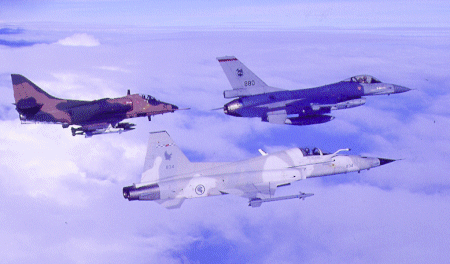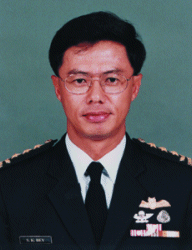Andrzej Jeziorski/SINGAPORE

Former US President Theodore Roosevelt famously based his foreign policy on the principle that one should "speak softly and carry a big stick". While Roosevelt may have been more inclined to apply his stick than most heads of state today, his idea survived and developed over the course of the 20th century, and continues to evolve in the 21st.
In the South-East Asian city-state of Singapore, it has evolved into a two-edged concept of national defence, summarised by defence force chief Lt Gen Bey Soo Khiang as "deterrence and defence diplomacy".

On the one hand, Singapore needs to be seen to have muscle - exemplified by its fighter force of Lockheed Martin F-16C/Ds, Northrop Grumman F-5S/T Tiger IIs and McDonnell Douglas A-4SU Skyhawks. On the other, it wants to stay on good terms with neighbouring countries. This includes establishing good relations between its armed forces and others, any one of which could, in some theoretical convolution of history, become an aggressor (although Singaporean officials have too much savvy ever to admit to such thoughts in public).
Over the past year or so, the international community has cast a critical eye on the archipelago of Indonesia, one of the world's most populous nations and Singapore's neighbour. The island group is in the throes of political change, with violent separatist and cultural unrest at some of its extremities. On top of all this, the country's military faces accusations of human rights abuses in East Timor, and there is tension between the civilian government and the traditionally powerful military.
Regional stability
Throughout, Singapore's government - seeking to maintain stability in the region - has been consistent in its diplomatic support for Jakarta. Meanwhile, relations between the countries' armed forces continue as normal, despite the evident friction between the civilian and military authorities in Indonesia. Bey says he sees Indonesia's troubles as "domestic events" which should have no influence on relations between the two neighbours.
In late January, the Indonesian air force (TNI-AU)teamed up as scheduled with the Republic of Singapore Air Force (RSAF) for a joint exercise, Camar Indopura II. The RSAF contingent consisted of Fokker 50 Maritime Enforcer 2s from 121 Sqn, based at Changi, and the event focused on maritime patrol and surveillance over the sea lanes surrounding Singapore and the Indonesian archipelago.
Camar Indopura II, centred at Indonesia's Supadio air base, was the second in a series of maritime surveillance exercises begun last August at Ranai air base on Natuna Island.
A senior Indonesian air force officer told national news agency Antara: "Most importantly, this joint exercise may forge stronger co-operation and inter-personal relationships between members of the two countries' air forces, which will lead in the end to strengthened bilateral relations."
This falls in line with Bey's "deterrence and diplomacy" concept. "We need to establish relationships with the armed forces in the region" he says - be they bilateral or multilateral.
Bilateral relations are maintained first and foremost by regular joint exercises with other air forces. Apart from its exercises with Indonesia, the RSAF also trains regularly with the Royal Malaysian Air Force, and held its annual Cope Tiger joint exercise with the US Air Force and the Royal Thai Air Force in November and January.
Cope Tiger was in two phases, starting with a command post exercise at Singapore's Paya Lebar AB in November, and concluding with a flying training exercise in Korat, Thailand, in January. This involved over 1,000 sorties flown by more than 60 fighter aircraft, including, for the first time, Singaporean F-16s.
Singapore also has several units permanently stationed abroad, allowing it to get around the training restrictions imposed by Singapore's size - sometimes described by fighter pilots (tongue in cheek)as "4 x 4min" in flying time - and to strengthen relations with its hosts.

These include F-16 units at Luke and Cannon AFBs in the USA, expected eventually to comprise 12 aircraft at each base, as well as a Boeing KC-135R Stratotanker unit at McConnell AFB. The RSAF has a training detachment of 12 Eurocopter AS332 Super Pumas based at Oakley, Australia; six Boeing CH-47 Chinooks at Grand Prairie, Texas, in the USA; and a Bell UH-1H detachment in Brunei.
There is a training school at Pearce in Australia, with 29 Aermacchi S211 jet trainers and 20 Aermacchi SF260M/Ws for screening, and a squadron of A-4s temporarily stationed at Cayaux, France. The RSAF has developed an air combat manoeuvring range at Pekan Baru, in Sumatra, with the TNI-AU, and is conducting fighter weapons training there and at the Siabu air weapons range.
"Of course there are professional mutual benefits which can be derived from such relationships: the potential to co-operate on joint projects to minimise expenditure is an attractive thing," says Bey. As an example of such savings, he mentions that the Australian Government is allowing the RSAF to use Pearce as its training school "at low cost".
"Besides the financial benefits and the benefit of airspace for training, such detachments allow us to work closely together with the other armed forces-[which] helps facilitate mutual learning," says Bey. As the RSAF builds its F-16 force, it is taking full advantage of USAF experience in F-16 operations via its Luke and Cannon detachments. "It allows us to steepen our learning curve on F-16C/D operations by working side-by-side with the USAF pilots and the USAF technicians," says Bey.
Logistics problem
He acknowledges that the scattering of a significant portion of Singapore's military around the world poses a challenging logistics problem, but chooses to adopt an optimistic slant on this issue. "If anything, this can be taken as a positive thing, because this keeps the logisticians on their toes. We have plans to redeploy as quickly as possible, when we need to-[and] the capability of the RSAF is not questioned," he says. Bringing RSAF resources back from abroad in an emergency would take "a matter of weeks", according to Bey.
The RSAF's capabilities are being upgraded constantly, as exemplified by the boost to air-to-air refuelling capabilities with the arrival of its KC-135s, and the outstanding order for Boeing AH-64 Apache attack helicopters.
The country has also issued manufacturers with requests for information on a potential new frontline fighter to begin replacing older A-4s as early as 2003. Types under consideration include the Dassault Rafale, Eurofighter Typhoon, and the F-16 Block 60. In March last year, Singapore became a low-level member of the US Joint Strike Fighter programme.
As the 30-year-old air force matures, it is playing a bigger role in international out-of-area operations, be they disaster relief or peacekeeping. "We want to be self-sufficient and independent, but we also want to be responsible members of the international community, within the constraints of our resources," says Bey.
So far, RSAF participation has been relatively low key, but its role is expanding. Four RSAF Super Pumas took part in a 1993 United Nations peacekeeping mission to Cambodia, and the air force has played its part in the UN Iraq-Kuwait Observer Mission, as well as in the recent International Force for East Timor operation. It has also participated in missions to Afghanistan and Angola.
Apart from its efforts at establishing bilateral relations, the only multilateral defence organisation in which Singapore is involved is the Five Powers Defence Arrangement (FPDA), which comprises Australia, Malaysia, New Zealand, Singapore and the UK. This organisation, established in 1971 after the UK Royal Air Force's withdrawal from the one-time British colony, offers loose mutual security commitments without being a binding agreement.
"It's a consultative arrangement," says Bey. "We get together and discuss security issues- [and] it allows us to exercise together." There are various annual exercises carried out under FPDA auspices.
The arrangement has experienced highs and lows, with one low point being Malaysia's temporary withdrawal from exercises in late 1998, related to disputes with Singapore. It was coaxed back into participating last year.
Bey believes the FPDA's lack of a binding mutual defence guarantee is "its advantage", making it more flexible and fitting in with Singapore's concept of individual bilateral arrangements combined with one multilateral arrangement without leading to conflicts. It does mean, however, that Singapore has to face the possibility, however unlikely, of standing alone in the event of hostilities.
Bey harks back to the Japanese rout of Singapore's overconfident British defenders in the Second World War, and the island's subsequent occupation. "World War II was a nasty experience, and we are very focused [on the fact] that we are the only ones who can defend our nation," says Bey.
International benefits
This makes it all the more important to reap the benefits of good international relations. The RSAF's latest efforts towards this are focused on its plans to host the Millennium Air Power Conference (MAPC) on 21 February, as part of Asian Aerospace 2000.
The RSAF expects over 600 participants in the MAPC, including air force chiefs and defence industry leaders. Speakers will include the chiefs of the air forces of Australia, Chile, China, France, Indonesia, Israel, Singapore and the US Pacific Air Forces.
Bey says the event's benefits will be heightened by its apolitical environment. "Such forums provide a platform for professionals to get together without touching on sensitivities," he says.
"One issue in which everybody is probably interested is this: given the pressure on defence budgets, how can we do business more effectively? One possible way is perhaps to think about having common trainers which we all can use - one international training school," says Bey. He says the RSAF is at the early stages of thinking about this, and that such a school could be established as a purely commercial venture, unconnected with any defence pact.
It is perhaps symptomatic of how the role of armed forces has changed over the last century that such an idea is even considered, or that air forces from countries often politically at odds would think of sharing their thoughts on the development of air warfare.
Yet Bey believes that there must be some transparency among armed forces, because "if you do not reveal anything, you do not have deterrence". He adds that another point in favour of mutual assistance among armed forces is the maintenance of regional stability.
"We must responsibly build our own defence capability to help ourselves, and then contribute to regional resilience," the defence force chief says. "For regional resilience, we do not want anybody to be weak."
Source: Flight International



















